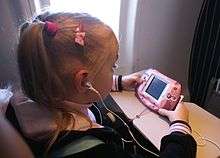Leapster
| Manufacturer | LeapFrog Enterprises |
|---|---|
| Product family | Leapster series |
| Type | Handheld game console |
| Media | Leapster cartridges |
| Successor | Leapster2 |
| Manufacturer | LeapFrog Enterprises |
|---|---|
| Product family | Leapster series |
| Type | Handheld game console |
| Retail availability | |
| Media | Leapster cartridges |
| Predecessor | Leapster |
| Successor | Leapster Explorer |

The Leapster Learning Game System is an educational handheld game console aimed at 4 to 10 year olds (preschool to fourth grade), made by LeapFrog Enterprises. Its games teach the alphabet, phonics, basic math (addition, subtraction, multiplication, division), and art and animal facts to players. Along with a directional pad, the system features a touchscreen with a stylus that enables young users to interact directly with the screen.
On February 5, 2008 LeapFrog announced the Leapster2 handheld device as a successor to the Leapster.[1] The Leapster2 is essentially the previous system with an added USB port and SD card slot. These additions give the ability to play a downloaded full game or short game including the ability to log data on gameplay, such as what has been learned by the user or art created by the user. Downloadable games are not for sale.[2]
Games released since the Leapster2's release log user activity and will send this data to LeapFrog's "Learning Path" system, which tracks educational milestones completed. Completion of certain learning activity can allow online games to be accessed, and in the case of art created on the device, the art can be further embellished online and printed with a printer accessible by the user's computer.
History
Released in late 2003, the Leapster has since undergone several revisions. The Leapster L-Max, which is a version that has one extra feature (a TV output, which allows the user to view and hear gameplay on their television) was released in 2004, and the console's size has decreased. The Leapster TV, a screenless version with the same basic control layout in a console form, was released in 2005.
The Leapster was the best-selling educational handheld, and has sold about 4 million units and 12 million software cartridges since its inception, as of May 2007. It is regularly sold in nine countries directly, and in another 7 for teaching English as a second language in schools.
Software
There are approximately 40 games available, and over 50 have been created. This is the largest library for any handheld designed exclusively for educational use.
All games for the Leapster feature a "Hint" function that will bring up audio or animated information on controls or the game's educational curriculum.
LeapFrog has not opened the Leapster platform to significant amounts of third-party or homebrew development; software is typically developed in-house or as work-for-hire.
Dave Bauer stated that there is a
"depressingly small library of software available for the Leapster... but some more varied software would make it much more interesting for (my son)... no platform that has ever been successful without third-party software.... Besides that, a strong hobbyist platform would be amazing."
Ian Bogost stated "the potential for improved educational game design is simply not going to come from inside the LeapFrog corporation."
Games licensed
- Mr. Pencil's Learn to Draw and Write
- Pet Pals
- Letters on the Loose
- Counting on Zero
- Math Baseball
- Creature Create
- Finding Nemo
- SpongeBob SquarePants
- The Incredibles
- Spider-Man
- Scooby-Doo
- Clifford the Big Red Dog
- Dora the Explorer
- Disney Princess
- Junie B. Jones Journal
- School House Rock
- Bratz (girls only)
- I Spy
- Math Missions
- Get Puzzled
- Animal Genius
- The Batman
- Madagascar
- Thomas & Friends
- The Backyardigans
- Cars
- Letter Factory
- Talking Words Factory
- Reading with Phonics: Mole's Huge Nose
- Foster's Home for Imaginary Friends
- Sonic X
- Noddy (UK only)
- Ratatouille
- Go Diego Go
- NASCAR
- Wall-E
- Ni Hao Kai Lan
- Star Wars: The Clone Wars: Jedi Math
- Star Wars: Jedi Reading
- Tangled
- Wolverine and the X-Men
- Tinker Bell and the Lost Treasure
- Toy Story
- Outwit
- Crayola
- The Princess and the Frog
- The Disney-PIXAR Collection
- Up
- Digging for Dinosaurs
- My Amusement Park
- Learning with Leap (cartridge-only game, built in on some Leapsters)
- Cars 2
- Letterpillar
- Number Raiders
- Word Chasers
- Cosmic Math
- Rock the World
- Kindergarten through 2nd Grade, grade based titles
Technical specifications
Hardware:
- CPU: Custom ASIC containing an ARCTangent-A5 CPU, running at 96 MHz.
- Memory: Original Leapster: 2MB onboard RAM, 256 bytes non-volatile. Leapster2: 16MB RAM, 128kbytes non-volatile storage
- Media type: Cartridges of 4-16MB with between 2 and 512kb non-volatile storage.
- Graphics: 4Mb ATI chip.
- Audio: Proprietary hardware audio acceleration.
- Screen: 160x160 CSTN with touchscreen.
- Leapster2 only: USB 1.1 (client only) and full-sized SD slot.
All of the software content for the original Leapster was created with Macromedia Flash MX 2004; the device runs a version of Adobe (formerly Macromedia) Flash Player ported to the Leapster, that is licensed to LeapFrog. Tom Prichard, Sr. Vice President of Marketing for Leapfrog, stated that he believed using Flash allowed them to "bring the Leapster system to life more rapidly than we could have with any other development method.”[7][8]
References
- ↑ http://gizmodo.com/352886/leapfrog-leapster2-and-didj-handheld-edu+gamers-for-the-pre+ipodcellphoneds-demographic
- ↑ http://www.geek.com/articles/games/first-look-preview-new-leapfrog-technology-leapster-2-didg-and-more-20080327/
- ↑ http://www.watercoolergames.org/archives/000023.shtml
- ↑ http://www.watercoolergames.org/archives/000157.shtml
- ↑ http://www.watercoolergames.org/archives/000117.shtml
- ↑ http://www.watercoolergames.org/archives/000518.shtml
- ↑ http://www.adobe.com/cfusion/showcase/index.cfm?event=casestudydetail&casestudyid=21019&loc=en_us
- ↑ http://www.slideshare.net/scottjanousek/bfpug-flash-lite-2-a-developers-perspective